Reducing Circling Currents in a VHF Class Φ2 Inverter Based on a Fully Analytical Loss Model
Abstract
1. Introduction
2. Topology and Operating Principles of a Class Φ2 Inverter
3. Analytical Loss Model for a Class Φ2 Inverter
3.1. Switching Node Voltage and Branch Currents Analysis
3.2. Analytical Loss Model for a Class Φ2 Inverter
3.3. Design Guidance to Reduce Total Loss
4. Simulation Results Comparisons
4.1. Branch Current Waveform Comparisons
4.2. Loss and Efficiency Comparisons
5. Experimental Results
5.1. Waveform Comparisons
5.2. Efficiency Comparisons
6. Conclusions
Author Contributions
Funding
Data Availability Statement
Acknowledgments
Conflicts of Interest
Appendix A
References
- Perreault, D.J.; Hu, J.; Rivas, J.M.; Han, Y.; Leitermann, O.; Pilawa-Podgurski, R.C.N.; Sagneri, A.; Sullivan, C.R. Opportunities and Challenges in Very High Frequency Power Conversion. In Proceedings of the 2009 Twenty-Fourth Annual IEEE Applied Power Electronics Conference and Exposition, Washington, DC, USA, 15–19 February 2009; pp. 1–14. [Google Scholar]
- Xu, D.; Guan, Y.; Wang, Y.; Wang, W. Topologies and control strategies of very high frequency converters: A survey. CPSS Trans. Power Electron. Appl. 2017, 2, 28–38. [Google Scholar] [CrossRef]
- Knott, A.; Andersen, T.M.; Kamby, P.; Pedersen, J.A.; Madsen, M.P.; Kovacevic, M.; Andersen, M.A.E. Evolution of Very High Frequency Power Supplies. IEEE J. Emerg. Sel. Top. Power Electron. 2014, 3, 386–394. [Google Scholar] [CrossRef]
- Rigot, V.; Phulpin, T.; Sakly, J.; Sadarnac, D. A New 7 kW Air-Core Transformer at 1.5 MHz for Embedded Isolated DC/DC Application. Energies 2022, 1, 5211. [Google Scholar] [CrossRef]
- Li, Y.; Ruan, X.; Zhang, L.; Lo, Y. Multipower-Level Hysteresis Control for the Class E DC–DC Converters. IEEE Trans. Power Electron. 2020, 3, 5279–5289. [Google Scholar] [CrossRef]
- Zhang, Y.; Feng, Y.; Liu, S.; Wu, J.; He, X. Impedance Matching Method for 6.78 MHz Class-E2-Based WPT System. Energies 2021, 1, 4289. [Google Scholar] [CrossRef]
- Liu, C.-Y.; Wang, G.-B.; Wu, C.-C.; Chang, E.Y.; Cheng, S.; Chieng, W.-H. Derivation of the Resonance Mechanism for Wireless Power Transfer Using Class-E Amplifier. Energies 2021, 1, 632. [Google Scholar] [CrossRef]
- Zhang, Z.; Zou, X.; Dong, Z.; Zhou, Y.; Ren, X. A 10-MHz eGaN Isolated Class-Φ2 DCX. IEEE Trans. Power Electron. 2017, 3, 2029–2040. [Google Scholar] [CrossRef]
- Zou, X.; Zhang, Z.; Dong, Z.; Zhou, Y.; Ren, X.; Chen, Q. A 10-MHz eGaN FETs Based Isolated Class-Φ2 DCX. In Proceedings of the 2016 IEEE Applied Power Electronics Conference and Exposition (APEC), Long Beach, CA, USA, 20–24 March 2016; pp. 2518–2524. [Google Scholar]
- Si-Yuan, C.; Jun-Ping, H.; Zi-Fan, L. Resonant DC/DC Converter with Class Φ2 Inverter and Class DE Rectifier based on GaN HEMT. Proceedings of thr 22nd European Conference on Power Electronics and Applications (EPE’20 ECCE Europe), Online, 7–11 September 2020; pp. 1–6. [Google Scholar]
- Guan, Y.; Wang, Y.; Wang, W.; Xu, D. A 20 MHz Low-Profile DC–DC Converter with Magnetic-Free Characteristics. IEEE Trans. Ind. Electron. 2020, 6, 1555–1567. [Google Scholar] [CrossRef]
- Gu, L.; Zulauf, G.; Stein, A.; Kyaw, P.A.; Chen, T.; Davila, J.M.R. 6.78-MHz Wireless Power Transfer with Self-Resonant Coils at 95% DC–DC Efficiency. IEEE Trans. Power Electron. 2021, 3, 2456–2460. [Google Scholar] [CrossRef]
- Choi, J.; Xu, J.; Makhoul, R.; Rivas, J. Design of a 13.56 MHz Dc-to-Dc Resonant Converter using an Impedance Compression Network to Mitigate Misalignments in a Wireless Power Transfer System. Proceedings of 2018 IEEE 19th Workshop on Control and Modeling for Power Electronics (COMPEL), Padova, Italy, 25–28 June 2018; pp. 1–7. [Google Scholar]
- Tang, X.; Zeng, J.; Pun, K.P.; Mai, S.; Zhang, C.; Wang, Z. Low-Cost Maximum Efficiency Tracking Method for Wireless Power Transfer Systems. IEEE Trans. Power Electron. 2018, 3, 5317–5329. [Google Scholar] [CrossRef]
- Zhang, Y.; Ma, J.; Tang, X. A CMOS Active Rectifier with Efficiency-Improving and Digitally Adaptive Delay Compensation for Wireless Power Transfer Systems. Energies 2021, 1, 8089. [Google Scholar] [CrossRef]
- Choi, J.; Ooue, Y.; Furukawa, N.; Rivas, J. Designing a 40.68 MHz Power-Combining Resonant Inverter with eGaN FETs for Plasma Generation. Proceedings of 2018 IEEE Energy Conversion Congress and Exposition (ECCE), Portland, OR, USA, 23–27 September 2018; pp. 1322–1327. [Google Scholar]
- Liang, W.; Raymond, L.; Praglin, M.; Biggs, D.; Righetti, F.; Cappelli, M.; Holman, B.; Davila, J.R. Low-Mass RF Power Inverter for CubeSat Applications Using 3-D Printed Inductors. IEEE J. Emerg. Sel. Top. Power Electron. 2017, 5, 880–890. [Google Scholar] [CrossRef]
- Stedman, Q.; Gu, L.; Pai, C.N.; Rasmussen, M.; Brenner, K.; Ma, B.; Ergun, A.S.; Davila, J.R.; Khuri-Yakub, B. Compact Fast-Switching DC and Resonant RF Drivers for a Dual-Mode Imaging and HIFU 2D CMUT Array. In Proceedings of the 2019 IEEE International Ultrasonics Symposium (IUS), Glasgow, UK, 6–9 October 2019; pp. 1951–1954. [Google Scholar]
- Yanagisawa, Y.; Miura, Y.; Handa, H.; Ueda, T.; Ise, T. Characteristics of Isolated DC–DC Converter with Class Phi-2 Inverter Under Various Load Conditions. IEEE Trans. Power Electron. 2019, 3, 10887–10897. [Google Scholar] [CrossRef]
- Guan, Y.; Wang, Y.; Wang, W.; Xu, D. A high-performance isolated high-frequency converter with optimal switch impedance. IEEE Trans. Ind. Electron. 2019, 66, 5165–5176. [Google Scholar] [CrossRef]
- Kitazawa, K.; Wei, X.; Katsuki, A.; Hirokawa, M. Analysis and Design of the Class-Φ2 Inverter. In Proceedings of the 44th Annual Conference of the IEEE Industrial Electronics Society, Washington, DC, USA, 21–23 October 2018; pp. 1023–1028. [Google Scholar]
- Roslaniec, L.; Jurkov, A.S.; Bastami, A.A.; Perreault, D.J. Design of Single-Switch Inverters for Variable Resistance/Load Modulation Operation. IEEE Trans. Power Electron. 2015, 3, 3200–3214. [Google Scholar] [CrossRef]
- Rivas, J.M.; Han, Y.; Leitermann, O.; Sagneri, A.D.; Perreault, D.J. A High-Frequency Resonant Inverter Topology with Low-Voltage Stress. IEEE Trans. Power Electron. 2008, 2, 1759–1771. [Google Scholar] [CrossRef]
- Panov, Y.; Huber, L.; Jovanović, M.M. Design Optimization and Performance Evaluation of Class Φ2 VHF DC/DC Converter. Proceedings of 2020 IEEE Applied Power Electronics Conference and Exposition (APEC), New Orleans, LA, USA, 15–19 March 2020; pp. 2170–2177. [Google Scholar]
- Lee, K.; Ha, J. Resonant Switching Cell Model for High-Frequency Single-Ended Resonant Converters. IEEE Trans. Power Electron. 2019, 3, 11897–11911. [Google Scholar] [CrossRef]
- Guan, Y.; Hu, X.; Zhang, S.; Wang, Y.; Xu, D.; Wang, W. A Novel Single Switch High-Frequency DC/DC Converter and Its Mathematical Model. IEEE Trans. Ind. Appl. 2019, 5, 3877–3888. [Google Scholar] [CrossRef]
- Ma, J.; Asiya; Wei, X.; Nguyen, K.; Sekiya, H. Analysis and Design of Generalized Class-E/F2 and Class-E/F3 Inverters. IEEE Access 2020, 8, 61277–61288. [Google Scholar] [CrossRef]
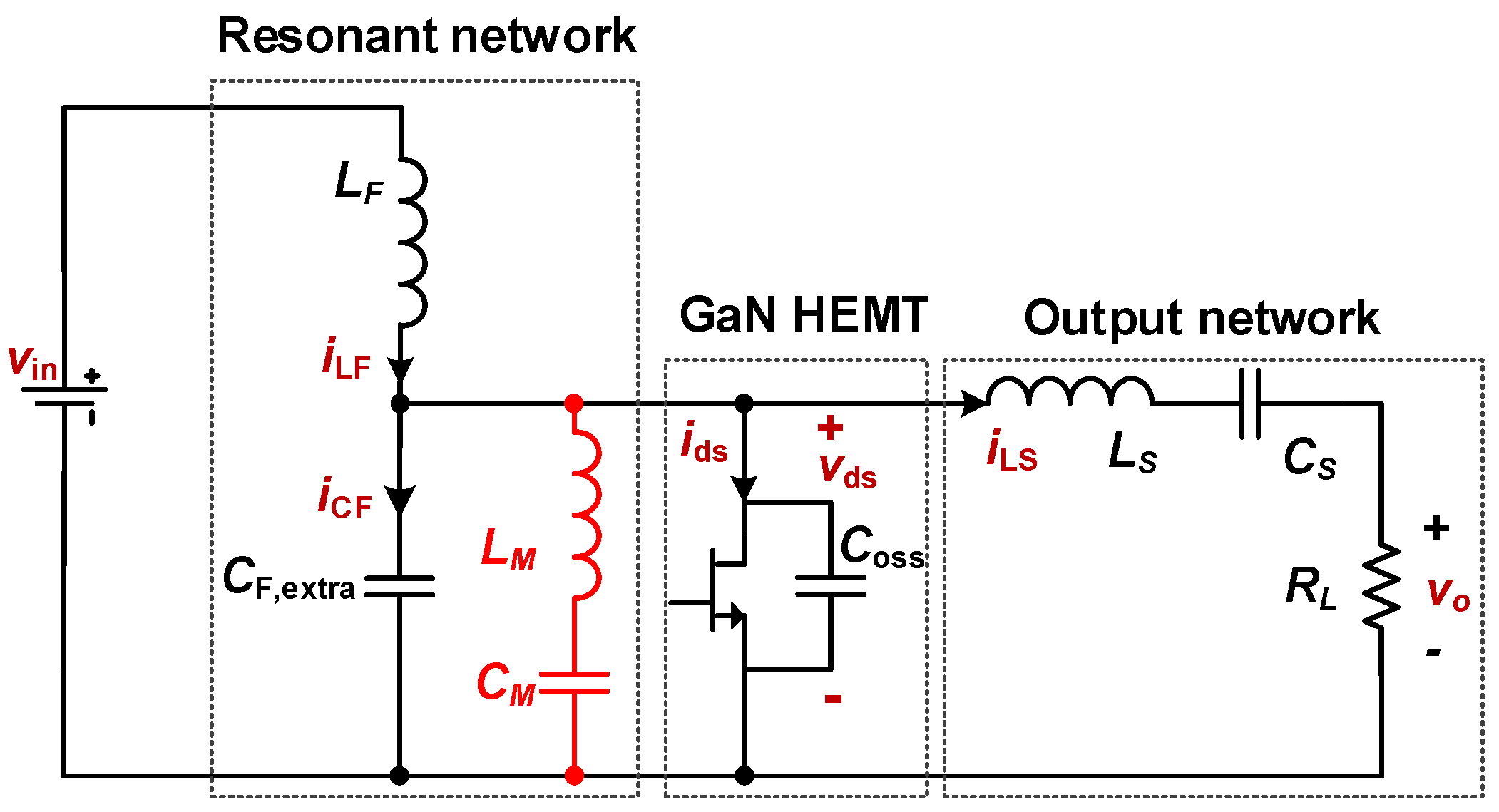


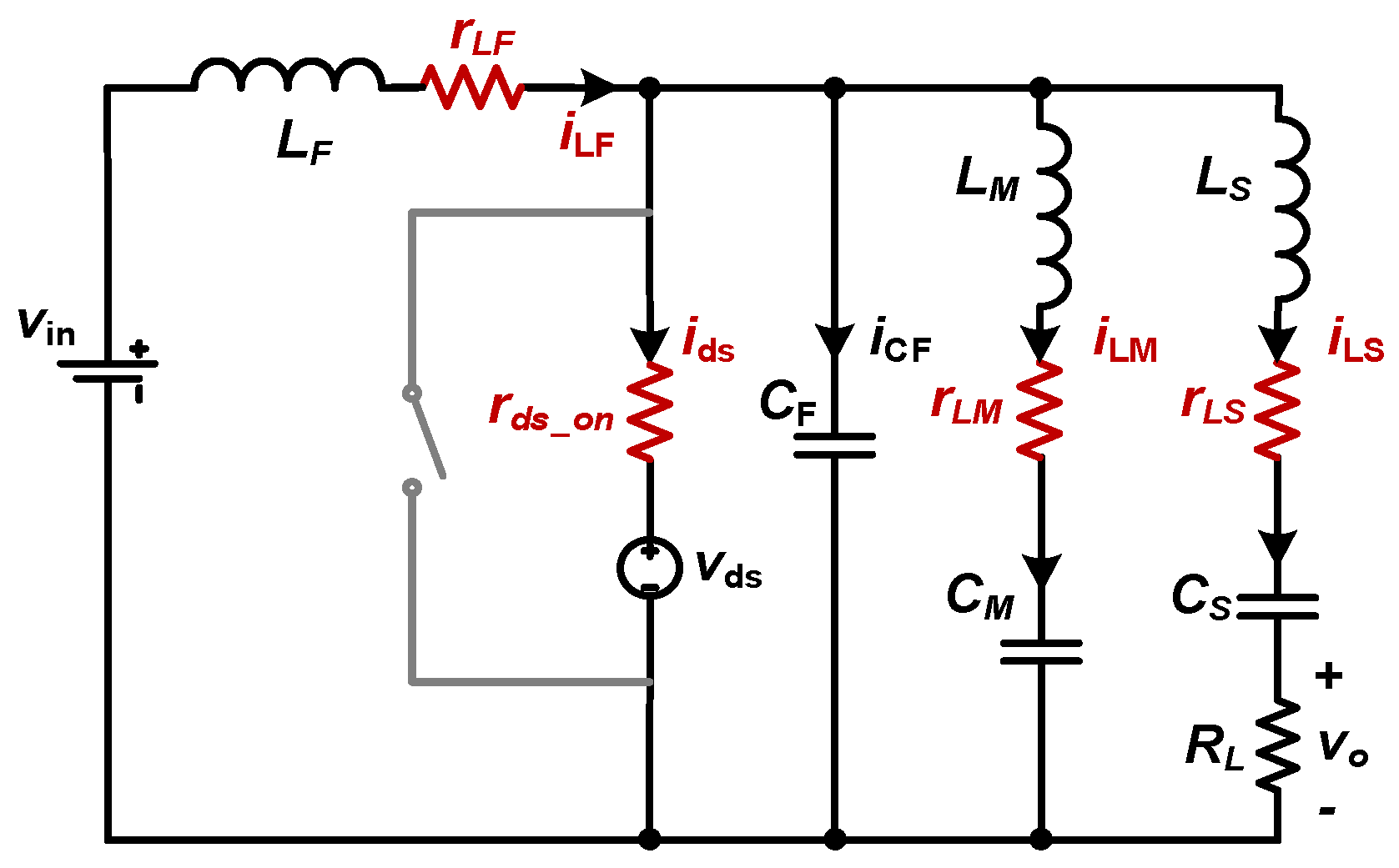


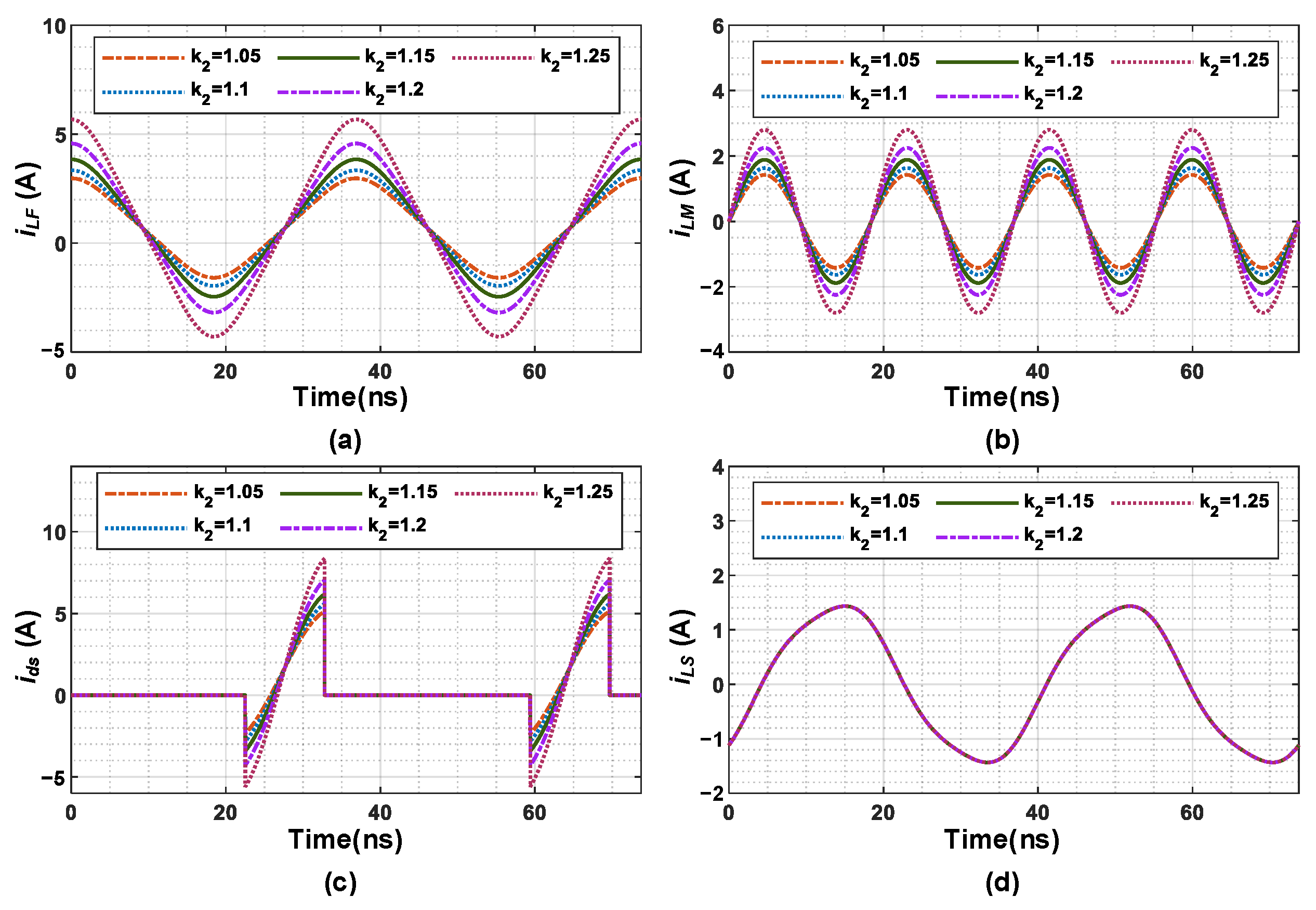

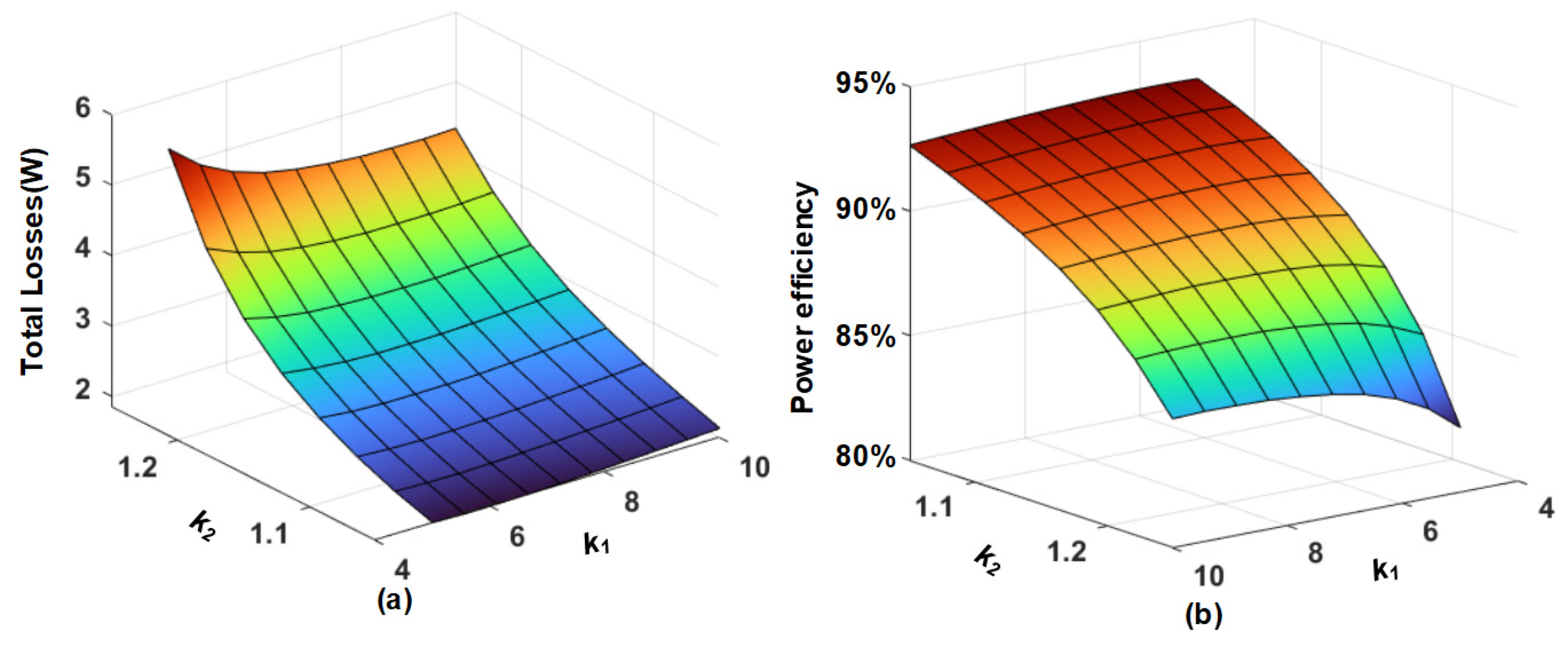

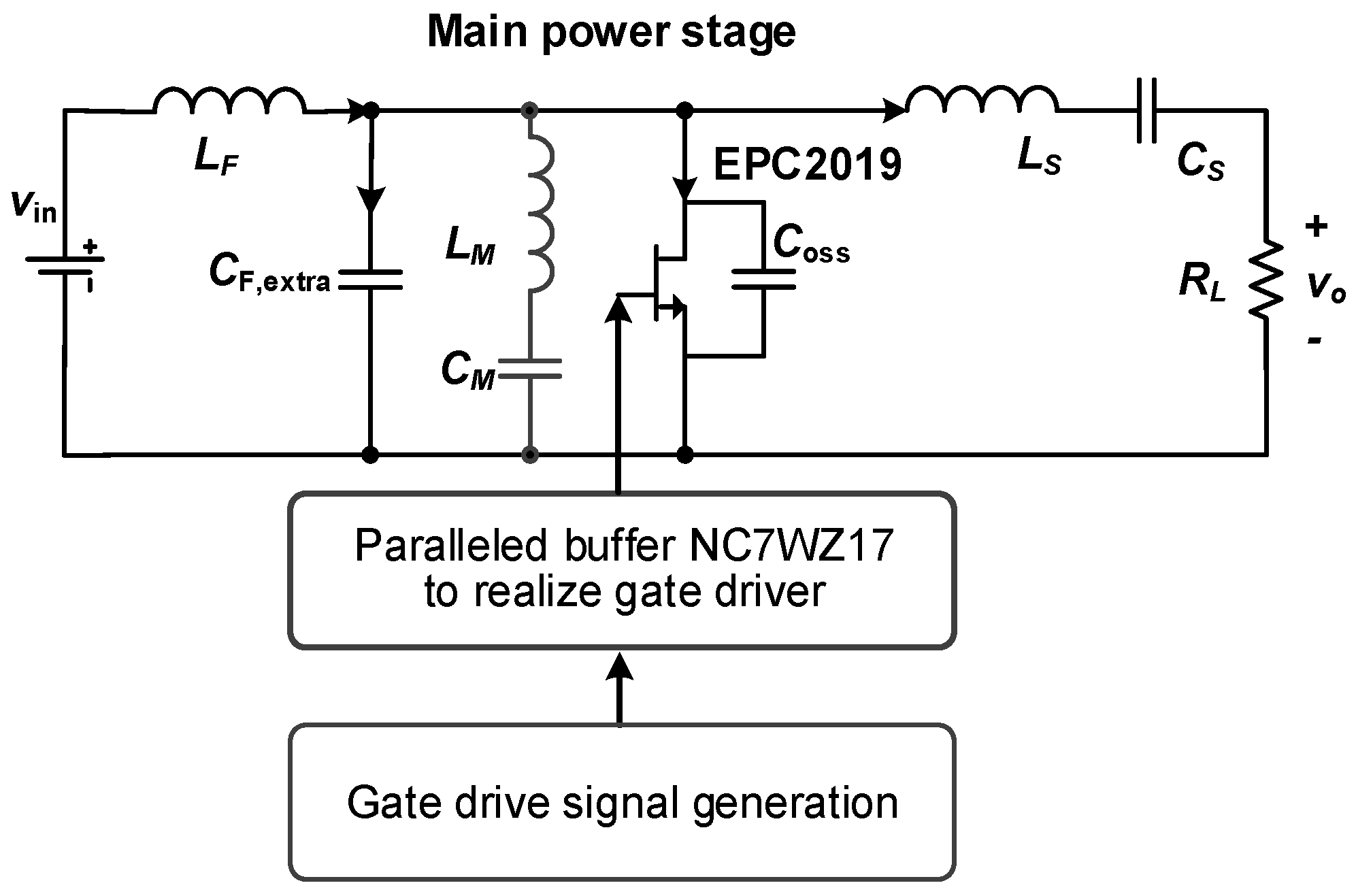
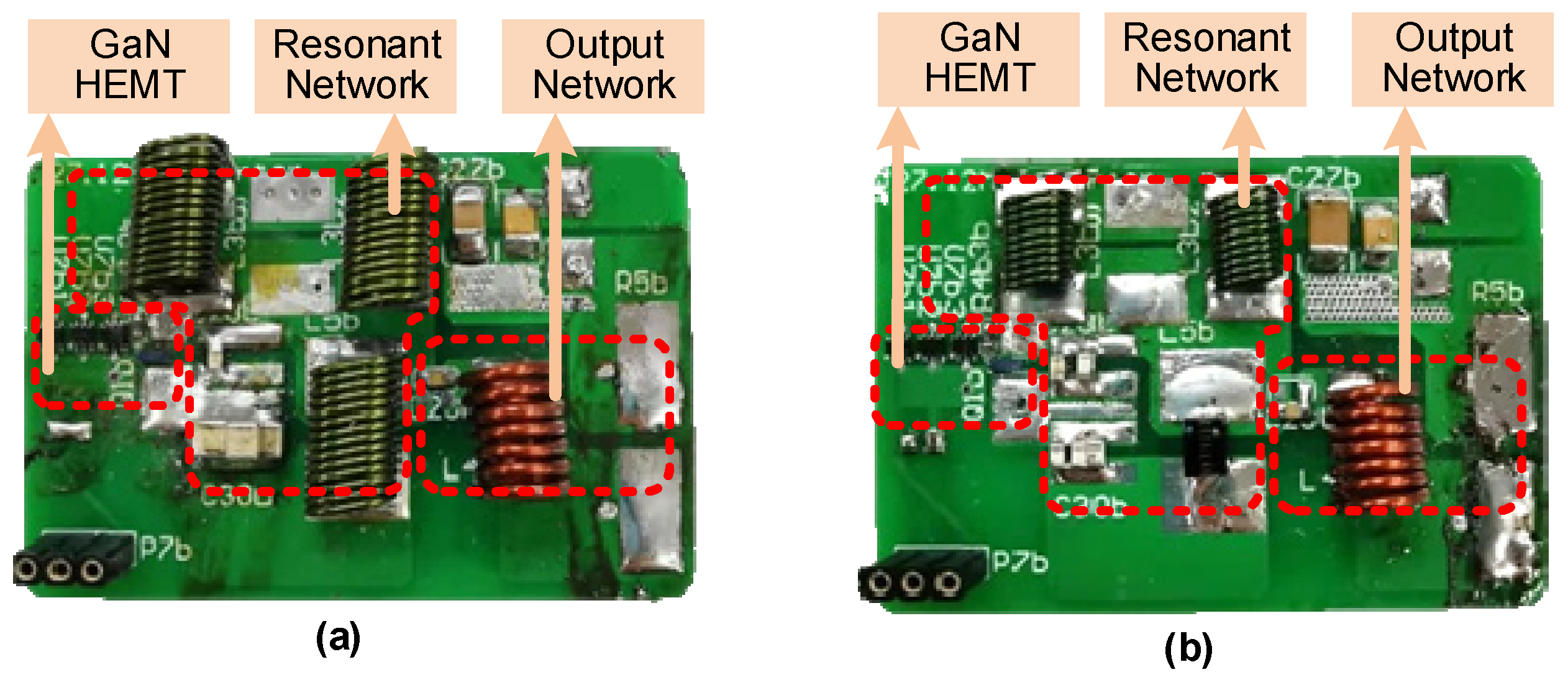
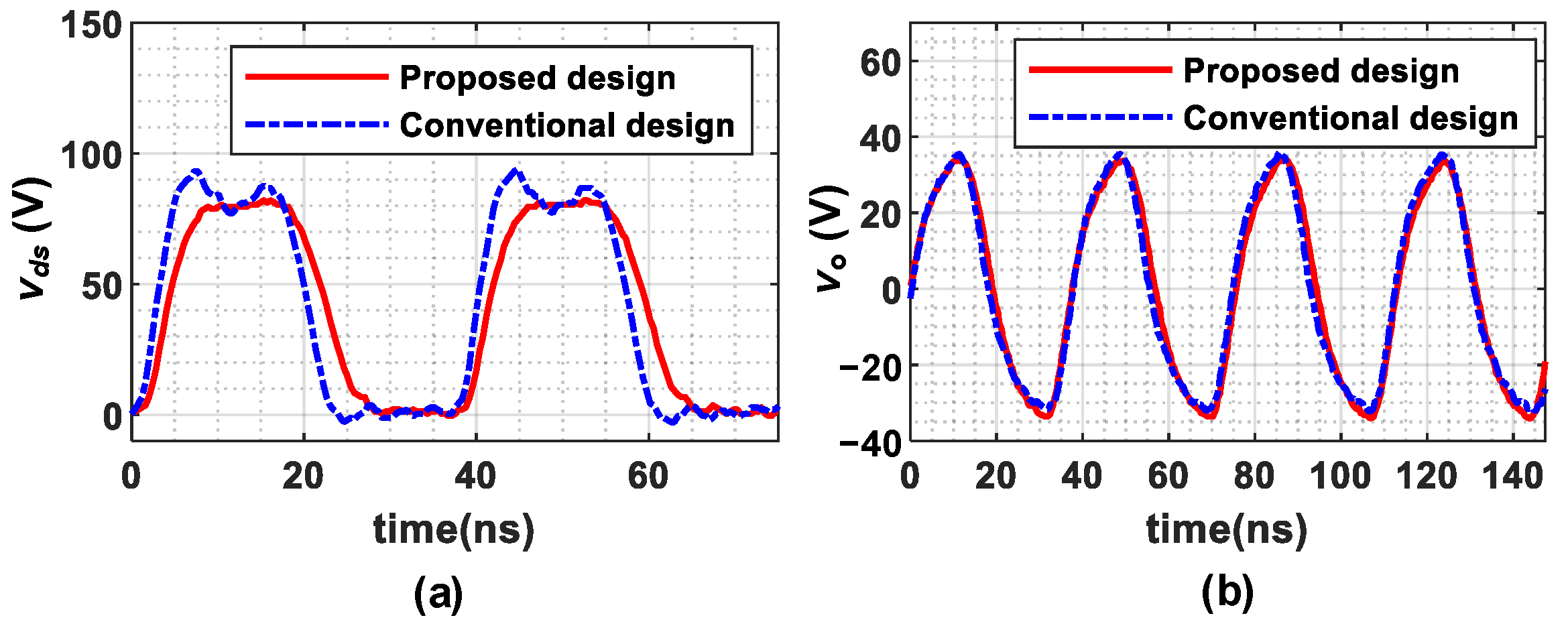
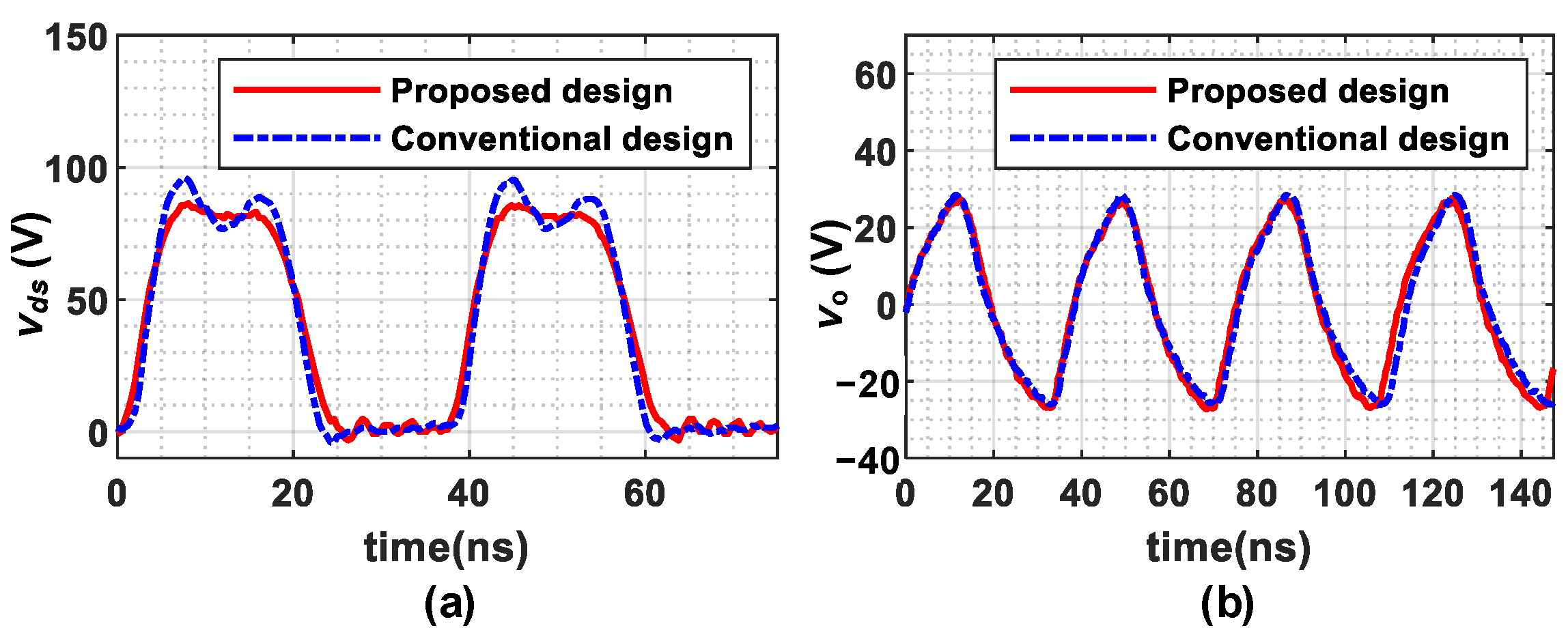
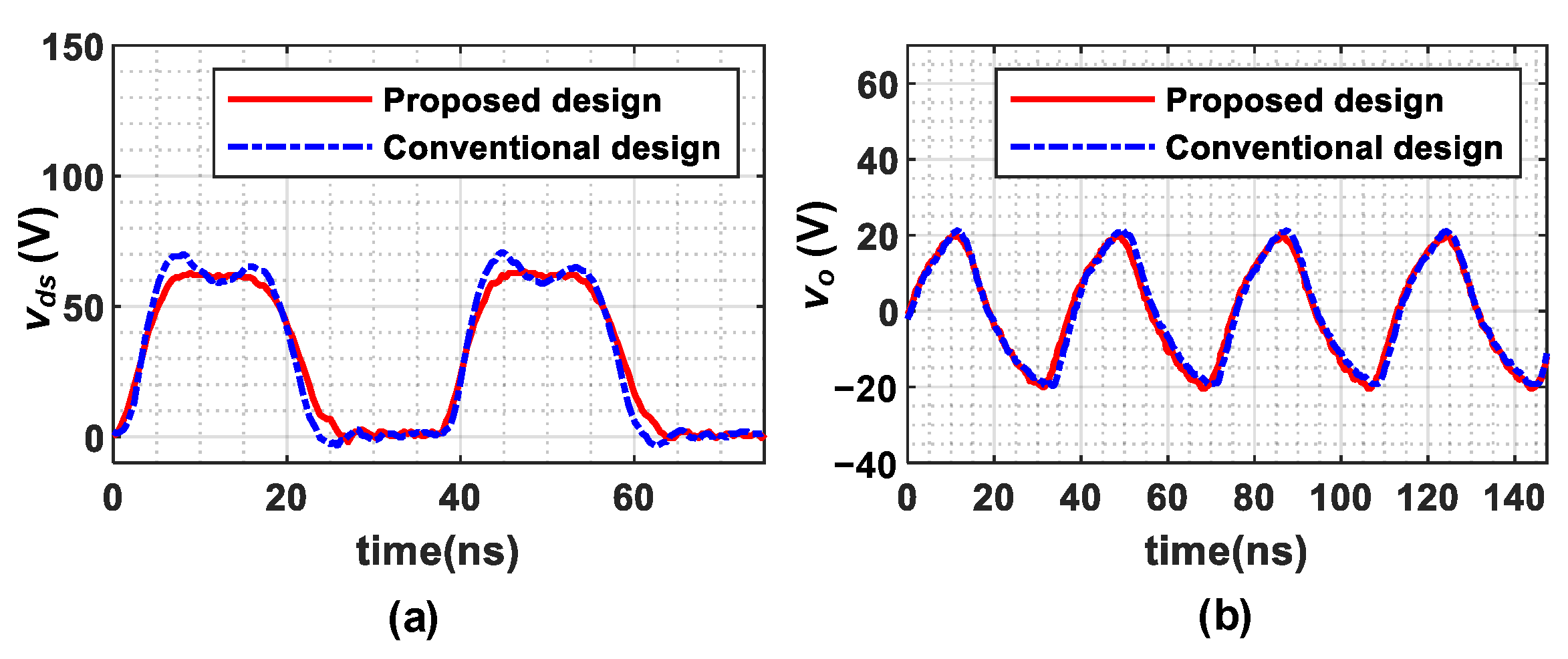

| Parameters | Values |
|---|---|
| Switching frequency | 27.12 MHz |
| Input voltage | 40 V |
| Output power | 25 W |
| Load resistance | 2.5–25 Ω |
| Parameters | Proposed Design Method | Conventional Design Method [23] |
|---|---|---|
| LF | 138 nH | 65 nH |
| CF | 205 pF | 262 pF |
| LM | 420 nH | 56 nH |
| CM | 20.2 pF | 150 pF |
| LS | 152 nH | 152 nH |
| CS | 4 nF | 4 nF |
| RL | 25 Ω | 25 Ω |
| Component | RL = 25 Ω | RL = 10 Ω | RL = 5 Ω | |||
|---|---|---|---|---|---|---|
| Proposed | Conventional | Proposed | Conventional | Proposed | Conventional | |
| LF | 1.60 A | 1.60 A | 1.60 A | 3.34 A | 1.60 A | 3.34 A |
| LM | 1.03 A | 1.03 A | 1.56 A | 2.22 A | 1.56 A | 2.22 A |
| LS | 0.97 A | 0.97 A | 1.33 A | 1.37 A | 1.33 A | 1.37 A |
| Power switch | 1.84 A | 1.84 A | 2.34 A | 2.76 A | 2.34 A | 2.76 A |
| Component | RL = 25 Ω | RL = 10 Ω | RL = 5 Ω | |||
|---|---|---|---|---|---|---|
| Proposed | Conventional | Proposed | Conventional | Proposed | Conventional | |
| LF | 0.54 W | 1.64 W | 0.54 W | 1.67 W | 0.51 W | 1.66 W |
| LM | 0.65 W | 1.98 W | 1.51 W | 2.96 W | 1.83 W | 3.31 W |
| LS | 0.31 W | 0.34 W | 0.58 W | 0.61 W | 0.67 W | 0.70 W |
| Power switch | 0.34 W | 0.52 W | 0.55 W | 0.76 W | 0.59 W | 0.80 W |
| Total loss | 1.84 W | 4.49 W | 3.18 W | 6.01 W | 3.60 W | 6.48 W |
| Parameters | Proposed Design Method | Conventional Design Method |
|---|---|---|
| LF | 140 nH | 60 nH |
| CF | 200 pF | 290 pF |
| LM | 430 nH | 56 nH |
| CM | 20 pF | 153 pF |
| LS | 150 nH | 150 nH |
| CS | 4.7 nF | 4.7 nF |
| RL | 25 Ω | 25 Ω |
| Power switch | EPC2019 | EPC2019 |
| Gate driver | 3 NC7WZ17 | 3 NC7WZ17 |
Publisher’s Note: MDPI stays neutral with regard to jurisdictional claims in published maps and institutional affiliations. |
© 2022 by the authors. Licensee MDPI, Basel, Switzerland. This article is an open access article distributed under the terms and conditions of the Creative Commons Attribution (CC BY) license (https://creativecommons.org/licenses/by/4.0/).
Share and Cite
Zhang, D.; Min, R.; Liu, Z.; Tong, Q.; Zhang, Q.; Wu, T.; Zhang, M.; Zhou, A. Reducing Circling Currents in a VHF Class Φ2 Inverter Based on a Fully Analytical Loss Model. Energies 2022, 15, 8572. https://doi.org/10.3390/en15228572
Zhang D, Min R, Liu Z, Tong Q, Zhang Q, Wu T, Zhang M, Zhou A. Reducing Circling Currents in a VHF Class Φ2 Inverter Based on a Fully Analytical Loss Model. Energies. 2022; 15(22):8572. https://doi.org/10.3390/en15228572
Chicago/Turabian StyleZhang, Desheng, Run Min, Zhigang Liu, Qiaoling Tong, Qiao Zhang, Ting Wu, Ming Zhang, and Aosong Zhou. 2022. "Reducing Circling Currents in a VHF Class Φ2 Inverter Based on a Fully Analytical Loss Model" Energies 15, no. 22: 8572. https://doi.org/10.3390/en15228572
APA StyleZhang, D., Min, R., Liu, Z., Tong, Q., Zhang, Q., Wu, T., Zhang, M., & Zhou, A. (2022). Reducing Circling Currents in a VHF Class Φ2 Inverter Based on a Fully Analytical Loss Model. Energies, 15(22), 8572. https://doi.org/10.3390/en15228572






